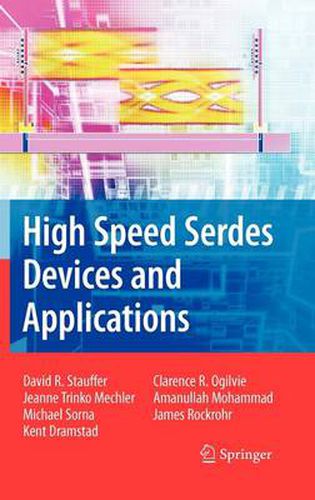Readings Newsletter
Become a Readings Member to make your shopping experience even easier.
Sign in or sign up for free!
You’re not far away from qualifying for FREE standard shipping within Australia
You’ve qualified for FREE standard shipping within Australia
The cart is loading…






This title is printed to order. This book may have been self-published. If so, we cannot guarantee the quality of the content. In the main most books will have gone through the editing process however some may not. We therefore suggest that you be aware of this before ordering this book. If in doubt check either the author or publisher’s details as we are unable to accept any returns unless they are faulty. Please contact us if you have any questions.
The simplest method of transferring data through the inputs or outputs of a silicon chip is to directly connect each bit of the datapath from one chip to the next chip. Once upon a time this was an acceptable approach. However, one aspect (and perhaps the only aspect) of chip design which has not changed during the career of the authors is Moore’s Law, which has dictated substantial increases in the number of circuits that can be manufactured on a chip. The pin densities of chip packaging technologies have not increased at the same pace as has silicon density, and this has led to a prevalence of High Speed Serdes (HSS) devices as an inherent part of almost any chip design. HSS devices are the dominant form of input/output for many (if not most) high-integration chips, moving serial data between chips at speeds up to 10 Gbps and beyond. Chip designers with a background in digital logic design tend to view HSS devices as simply complex digital input/output cells. This view ignores the complexity associated with serially moving billions of bits of data per second. At these data rates, the assumptions associated with digital signals break down and analog factors demand consideration. The chip designer who oversimplifies the problem does so at his or her own peril.
$9.00 standard shipping within Australia
FREE standard shipping within Australia for orders over $100.00
Express & International shipping calculated at checkout
This title is printed to order. This book may have been self-published. If so, we cannot guarantee the quality of the content. In the main most books will have gone through the editing process however some may not. We therefore suggest that you be aware of this before ordering this book. If in doubt check either the author or publisher’s details as we are unable to accept any returns unless they are faulty. Please contact us if you have any questions.
The simplest method of transferring data through the inputs or outputs of a silicon chip is to directly connect each bit of the datapath from one chip to the next chip. Once upon a time this was an acceptable approach. However, one aspect (and perhaps the only aspect) of chip design which has not changed during the career of the authors is Moore’s Law, which has dictated substantial increases in the number of circuits that can be manufactured on a chip. The pin densities of chip packaging technologies have not increased at the same pace as has silicon density, and this has led to a prevalence of High Speed Serdes (HSS) devices as an inherent part of almost any chip design. HSS devices are the dominant form of input/output for many (if not most) high-integration chips, moving serial data between chips at speeds up to 10 Gbps and beyond. Chip designers with a background in digital logic design tend to view HSS devices as simply complex digital input/output cells. This view ignores the complexity associated with serially moving billions of bits of data per second. At these data rates, the assumptions associated with digital signals break down and analog factors demand consideration. The chip designer who oversimplifies the problem does so at his or her own peril.